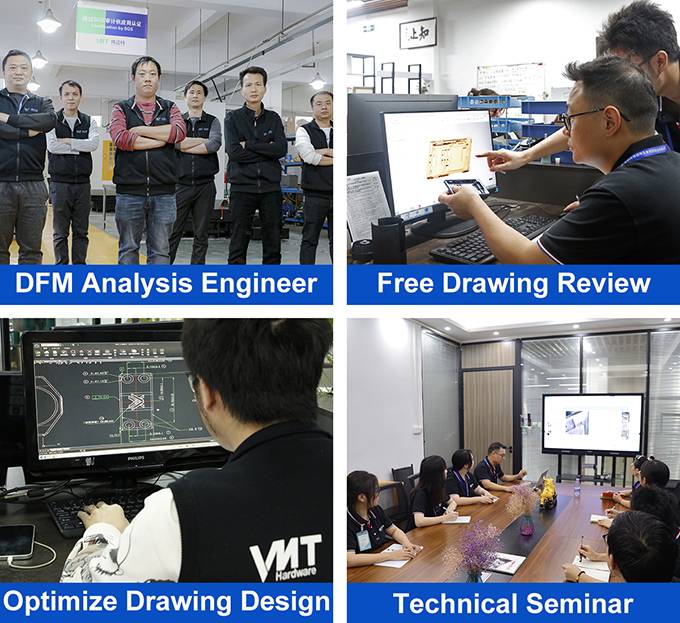15 years one-stop China custom CNC machining parts factory

Hey there I’m VMT Sam!
With 25 years of CNC machining experience we are committed to helping clients overcome 10000 complex part-processing challenges all to contribute to a better life through intelligent manufacturing. Contact us now
 256 |
Published by VMT at Feb 02 2024
256 |
Published by VMT at Feb 02 2024
Introduction:
In today's fiercely competitive market environment, customer expectations for service and support from suppliers have reached new heights. For manufacturers of CNC machined parts, delivering swift responses and assisting in resolving customer issues and requests are crucial. This article explores how CNC machined parts manufacturers can effectively meet customer needs and deliver exceptional customer service.

I. Establishing an Efficient Customer Service Team:
Selecting Outstanding Talent:
Recruit individuals with expertise, communication skills, and problem-solving abilities to form an efficient customer service team.
Providing Training and Support:
Regularly provide training for the customer service team on product knowledge, technical insights, and communication skills to ensure their capability to offer professional services.
Clearly Defining Roles and Responsibilities:
Clearly outline the roles and responsibilities of the customer service team to ensure prompt response and resolution of customer issues.
Establishing Effective Communication Channels:
Provide various communication channels (such as phone, email, online chat, etc.) to facilitate customers in contacting the customer service team at any time.

II. Timely Responding to Customer Needs and Issues:
Swift Response:
Set reasonable response times to ensure timely attention and resolution of customer issues. For urgent matters, provide emergency response services to swiftly address customer concerns.
Proactive Communication:
Proactively stay in touch with customers to understand their needs and issues, offering solutions and suggestions. Through regular follow-ups, ensure customer satisfaction and loyalty.
Recording and Tracking:
Establish a mechanism for recording and tracking issues to ensure proper handling and resolution. Provide timely feedback to customers on the progress and results of issue resolution, demonstrating care and attention.
Periodic Review and Improvement:
Periodically review and evaluate the customer service process, identifying problems and areas for improvement. Implement measures to enhance the quality of customer service based on these findings.

III. Providing Technical Support and Solutions:
Technical Support:
Offer technical consultation and support services to help customers address technical challenges in their production processes. Provide targeted solutions based on professional knowledge and experience.
Technical Training:
Provide technical training services to customers based on their needs, enhancing their technical proficiency and operational capabilities. Assist customers in maximizing the potential of the equipment.
Customized Solutions:
Understand the specific needs and requirements of customers and tailor solutions accordingly. Collaborate with customers to achieve efficient and high-quality production goals.
Technical Exchange and Sharing:
Organize regular technical exchange and sharing sessions, inviting customers to participate. Discuss industry trends and technological innovations to deepen connections and cooperation with customers.
IV. Continuous Optimization of Customer Service Processes:
Process Streamlining:
Conduct a comprehensive review and analysis of customer service processes to identify bottlenecks and shortcomings.
Process Improvement:
Develop improvement measures and plans to continuously optimize customer service processes. Enhance customer satisfaction by simplifying processes and improving efficiency.
Customer Feedback Mechanism:
Establish an effective customer feedback mechanism to collect opinions and suggestions. Incorporate this feedback into the process optimization process for continuous improvement.
Periodic Assessment and Improvement:
Regularly evaluate and summarize the effectiveness of customer service. Analyze existing problems and shortcomings, implement improvements, and ensure the continuous improvement of service quality.
V. Building Long-Term Collaborative Relationships and Loyalty Programs:
Building Trust Relationships:
Build mutual trust with customers by providing high-quality service and technical support. Maintain good communication and collaboration throughout the partnership to address challenges together.
Loyalty Programs:
Establish loyalty programs to encourage long-term cooperation. Provide rewards and discounts based on customer collaboration and contributions. Through loyalty programs, strengthen customer relationships and foster long-term development.
Continuous Monitoring of Customer Needs:
Stay attuned to changes in customer needs amidst market shifts and technological developments. As CNC machined parts manufacturers, continuously monitor customer demands, adjusting service strategies and product offerings promptly to meet evolving needs. Through close communication and collaboration with customers, grow together and achieve mutual development.
Sharing Case Studies and Successful Practices:
Showcase the ability and strengths of the manufacturer in solving practical problems by sharing success stories and best practices. These cases can include actual production scenarios, industry benchmarks, or success stories of other customers. Through sharing, enhance customer trust and willingness to collaborate.
Cross-Industry Collaboration and Resource Integration:
Actively seek collaboration opportunities with other industries and professional domains. Through resource integration and innovative models, provide customers with more comprehensive and efficient services. Cross-industry collaboration can expand the service scope and market influence of manufacturers, bringing additional value and service experiences to customers.
In conclusion, CNC machined parts manufacturers must employ a multifaceted approach to provide swift responses and assist in resolving customer issues and requests. By establishing an efficient customer service team, responding promptly to customer needs, offering technical support and solutions, continuously optimizing customer service processes, and building long-term collaborative relationships, manufacturers can continually enhance customer service quality and satisfaction. This will help gain customer trust and support, strengthen market competitiveness, and achieve sustainable development goals.
Ready To Start Your Next Project?
Get Instant Quote

Request a Free Quote
Send us a message if you have any questions or request a quote. We will get back to you ASAP!